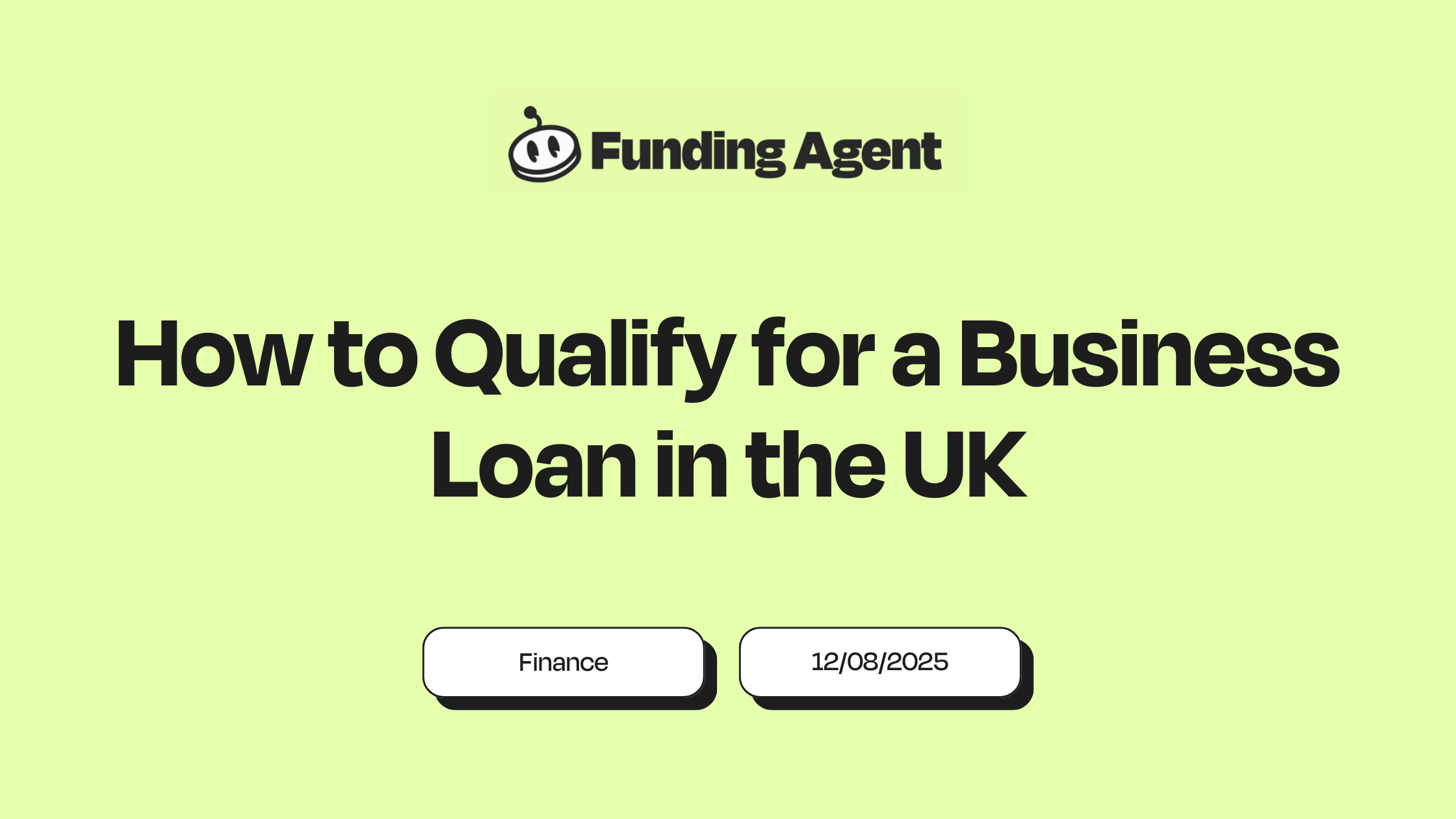

How to Qualify for a Business Loan in the UK: A Step-by-Step Guide for SMEs and Startups


Qualifying for a business loan starts with fit, evidence, and speed. Pick the right product for the job. Prove affordability from recent cash flow. Prepare a tight document pack. Reply quickly during underwriting. Do those four things and your odds rise.

New to Funding Agent? Start on the homepage. For more guides, browse the blog. To check eligibility now, use the form.
Quick answer, what lenders need to see
- Clear use of funds and the right product choice
- Proof of trading and stable inflows
- Clean credit files or simple context for any blips
- Security decision, secured or personal guarantee, where relevant
- A complete documents pack that matches the numbers in your bank
- Fast, consistent answers during underwriting
Steps to qualify, from need to offer
The process is simple when you set it up right. Map your need to a product, check eligibility, prove affordability, prepare documents, and move fast to offer.
Step 1, match your need to the right product
Pick a product that fits the job. This improves approval odds and saves time.
- Working capital or uneven cash flow: consider a revolving line or overdraft
- Equipment or vehicles: consider asset finance or a secured term loan
- One off projects or expansion: consider a term loan with a clear end date
- Invoices paid slowly: consider invoice finance or selective invoice discounting
Step 2, check basic eligibility
Confirm the basics before you apply. This avoids dead ends and hard searches.
- UK based business and directors
- Legal structure in good standing
- Minimum trading time for the lender you choose
- Turnover that supports the requested limit
- No major compliance gaps, for example missing accounts (Companies House filing)
If you are early stage, consider smaller unsecured loans or government backed options. You will still need a plan and simple forecasts, plus personal ID and proof of address for KYC.
Step 3, prove affordability from cash flow
Lenders look at money in and money out, not just top line revenue. They review business bank statements and accounts. They want to see stable inflows and headroom after expenses.
Use a simple rule of thumb. Keep total monthly repayments well below average monthly net inflows. If your average net inflow is £20,000 per month, do not take on £15,000 in repayments. Leave room for seasonality, VAT, and one off costs.
- Summarise six to twelve months of bank statements
- Note seasonality and explain any spikes
- List existing facilities and repayments
- Share a brief forecast that ties to recent performance
- Keep loan repayments comfortably below average monthly inflows
Step 4, decide on security or a personal guarantee
Security changes price, limit, and speed.
- Secured loans: use assets as collateral. Limits can be larger and rates lower. Timelines can be longer due to valuations and legal work.
- Unsecured loans: move faster. Many require a personal guarantee from a director. Limits can be smaller and pricing higher.
- Blended structures: for example a debenture plus a personal guarantee.
Decide early. This shapes which lenders fit your case and what documents you will need.
Step 5, prepare the documents pack
A complete pack speeds decisions. Prepare it before you click apply.
Core items most lenders ask for:
- Six to twelve months of business bank statements
- Filed accounts or recent management accounts
- Recent VAT returns or corporation tax returns (HMRC VAT guidance), when they help the story
- Director ID and proof of address for KYC
- A short business plan and a simple forecast, when you are growing or changing
Smaller firms are often assessed with a blend of business and personal credit data. Clean files help.
- Check business and personal reports for errors (Experian, Equifax, TransUnion)
- Pay suppliers and existing facilities on time
- Avoid maxing out credit lines
- Reduce bounced payments and failed direct debits
- Add positive data where possible, for example trade references
Step 7, apply and respond fast
Use an eligibility checker first, it avoids unnecessary hard searches. When you apply, keep answers short and consistent with your documents.
Expect follow up questions on:
- Seasonality and cash flow dips
- Existing facilities and repayment schedules
- Any CCJs or late payments
- Large one off inflows or outflows
Answer within hours, not days. Fast, clear responses keep your file at the top of the queue.
Startup vs established, realistic routes
Startups
- Smaller unsecured loans with personal guarantees
- Government backed options where eligible
- Micro facilities as a bridge while traction builds
- A clear plan and early signs of revenue or contracts
Established SMEs
- Term loans for projects with a defined payback
- Asset finance for equipment, vehicles, or machinery
- Revolving credit for working capital and seasonality
- Invoice finance to release cash tied up in receivables
Keep the ask aligned with trading history and headroom. If your average monthly net inflow is £50,000, a £500,000 term loan may be a stretch without security and strong margins. Build up in steps if needed.
Common pitfalls that sink good applications
- Vague loan purpose, the lender cannot map risk to use
- Mismatched product, term loan for short term cash gaps
- Forecasts that do not match bank statements
- Unfiled accounts or late filings
- Unexplained CCJs or returned payments
- Asking for too much, too early
- Missing documents or inconsistent numbers across the pack
Fix these before you apply. Your time to decision will drop. Your approval odds will rise.
Where Funding Agent helps
Funding Agent matches product to purpose, packages your application, and reduces friction in underwriting. We check your documents, model affordability, and brief you on likely follow up questions. That saves time and lifts approval odds. During underwriting we submit a complete pack, answer lender queries fast, and guide security or personal guarantee choices; at offer stage we explain rate, fees, term, security, and early repayment rules in plain English, compare options side by side, and support drawdown; expect a quick online journey with personalised shortlists and fast decisions, use the business loan calculator to model repayments, or contact us for tailored guidance.

